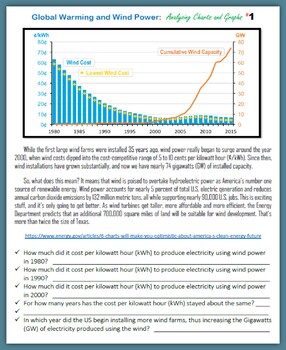Global Warming and Wind Power - Analyzing Charts and Graphs
- PDF
- Easel Activity
Also included in
- 84 printable or digital pages exploring wind power and global warming: internet activities (WebQuest and Google) - 12 pagesanalyze global warming charts and graphs - 17 pagescompare and contrast - 10 pageswriting prompts - 20 pagesbrainteasers and word puzzles - 25 pagesUse in a computer lab or atPrice $7.00Original Price $13.50Save $6.50
Description
17 printable or digital pages for students to analyze charts and graphs on global warming and wind power:
- Wind farms,
- Residential wind turbines,
- Which states are investing money into this renewable resource,
- How the cost has gone down,
- The top nations of the world in this industry,
- Noise pollution from turbines,
- Injuries to birds,
- Reduction of carbon dioxide emissions,
- Offshore wind farms,
- and more...
PRINT: I created a PDF version that you can download on your computer and print for students to use in class or at home. Click on "Add one to cart" and download your copy.
DIGITAL ACTIVITY: I created a digital version with text boxes so students can type in the answers using a computer or tablet (for Distance Learning). Click on "Create Digital Activity" and link the activities to your Google Classroom. Online Resource. Yes, I already added the interactive layer to each page. Enjoy!
Use in a computer lab or at home (as homework or distance learning). Take a look at the Preview to see sample pages. And if you want more on WIND POWER, then take a look at the others in this series:
Global Warming and Wind Power - Analyzing Charts and Graphs - 17 pages
Global Warming and Wind Power - Brainteasers and Word Puzzles - 25 pages
Global Warming and Wind Power - Compare and Contrast - 10 pages
Global Warming and Wind Power - Internet Activities - 12 pages
Global Warming and Wind Power - Writing Prompts - 20 pages
And if you want more CHARTS and GRAPHS:
Food Charts and Graphs - 21 pages
Winter Weather Charts and Graphs - 20 pages
Christmas Charts and Graphs - 20 pages
Winter Olympics (Reading Charts and Graphs) - 10 pages
Presidents' Day - Analyzing Charts and Graphs - 22 pages
Immigration - Charts and Graphs (Mexico) - 23 pages
Covid-19 (Coronavirus) Analyzing Charts and Graphs - 58 pages
Mushrooms - Charts and Graphs, Describing, Compare and Contrast, Writing - 11 pages
Global Warming and Solar Energy - Analyzing Charts and Graphs - 17 pages
Global Warming and Wind Power - Analyzing Charts and Graphs - 17 pages
Global Warming and Animals - Analyzing Charts and Graphs - 15 pages
Global Warming and Coal - Analyzing Charts and Graphs - 15 pages
Global Warming and the Ocean - Analyzing Charts and Graphs - 15 pages
Global Warming and Temperature - Analyzing Charts and Graphs - 13 pages
Global Warming and Glaciers - Analyzing Charts and Graphs - 11 pages
Global Warming and Transportation - Analyzing Charts + Graphs - 15 pages
Global Warming and Trash - Analyzing Charts + Graphs - 16 pages
And if you want more on GLOBAL WARMING:
Storms, Hurricanes, Tornadoes and Global Warming - 20 pages
Will Plants Survive Global Warming - 24 pages
Electricity and Global Warming - 24 pages
What Will Happen to our Food with Global Warming - 20 pages
How Buildings Contribute to Global Warming - 30 pages
Greta Thunberg - Internet Research Projects - 35 pages
Greta Thunberg - Quotes about Global Warming and the Climate Crisis - 17 pages
Greta Thunberg - Writing Prompts on Global Warming - 23 pages







